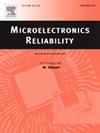Performance and reliability analysis of redistribution layers under interfacial crack
IF 1.9
4区 工程技术
Q3 ENGINEERING, ELECTRICAL & ELECTRONIC
引用次数: 0
Abstract
The growing demand for high-density and high-performance semiconductor devices has accelerated the adoption of three-dimensional (3D) integration technologies, where redistribution Layer (RDL) structures play a critical role in signal routing and interconnect reliability. However, as the technology advances, it imposes significant stress on the RDL structure that can compromise its mechanical integrity and lead to cracks formation. Consequently, the likelihood of crack formation within these structures increases, and neglecting these issues can lead to severe problems, including reduced device performance and even permanent damage to the device. To address these confronting challenges, the study proposes an analytical modeling to analyze the influence of the RDL structure, considering interfacial cracks in both heating and cooling conditions. In this context, the result reveals a notable improvement in the crosstalk delay, with a reduction of 22.29 % observed when the minimum crack width of 0.18 μm under heating conditions approached the defect-free condition. A thorough validation of the analytical results demonstrates an excellent agreement with the electromagnetic (EM) result, for a negligible deviation of only 3.4 % observed in the scattering parameter. This close correspondence between the simulated and quantitative results lends solid support for the accuracy and reliability of the research findings. Additionally, the analysis highlighted that the crack under the cooling condition is significantly more susceptible to power delay product (PDP) than heating conditions, with a vulnerability of 7.19 % higher at a crack width of 0.18 μm. These findings provide valuable insight into the effects of interfacial cracks on the via performance and offer a robust foundation for ensuring high-density packages of semiconductors.
界面裂纹作用下重分布层的性能及可靠性分析
对高密度和高性能半导体器件不断增长的需求加速了三维(3D)集成技术的采用,其中再分配层(RDL)结构在信号路由和互连可靠性中起着关键作用。然而,随着技术的进步,它对RDL结构施加了巨大的应力,这可能会损害其机械完整性并导致裂缝的形成。因此,这些结构中裂纹形成的可能性增加,忽视这些问题可能导致严重的问题,包括降低设备性能,甚至对设备造成永久性损坏。为了解决这些面临的挑战,该研究提出了一个分析模型来分析RDL结构的影响,同时考虑了加热和冷却条件下的界面裂纹。在这种情况下,结果表明,当最小裂纹宽度为0.18 μm时,在加热条件下,串扰延迟明显改善,达到无缺陷状态时,串扰延迟降低了22.29%。对分析结果的彻底验证表明,分析结果与电磁(EM)结果非常吻合,散射参数的偏差仅为3.4%,可以忽略不计。模拟结果与定量结果的密切对应,为研究结果的准确性和可靠性提供了有力的支持。此外,分析还指出,冷却条件下的裂纹对功率延迟积(PDP)的敏感性显著高于加热条件下的裂纹,裂纹宽度为0.18 μm时的脆弱性高出7.19%。这些发现为界面裂纹对通孔性能的影响提供了有价值的见解,并为确保半导体的高密度封装提供了坚实的基础。
本文章由计算机程序翻译,如有差异,请以英文原文为准。
求助全文
约1分钟内获得全文
求助全文
来源期刊

Microelectronics Reliability
工程技术-工程:电子与电气
CiteScore
3.30
自引率
12.50%
发文量
342
审稿时长
68 days
期刊介绍:
Microelectronics Reliability, is dedicated to disseminating the latest research results and related information on the reliability of microelectronic devices, circuits and systems, from materials, process and manufacturing, to design, testing and operation. The coverage of the journal includes the following topics: measurement, understanding and analysis; evaluation and prediction; modelling and simulation; methodologies and mitigation. Papers which combine reliability with other important areas of microelectronics engineering, such as design, fabrication, integration, testing, and field operation will also be welcome, and practical papers reporting case studies in the field and specific application domains are particularly encouraged.
Most accepted papers will be published as Research Papers, describing significant advances and completed work. Papers reviewing important developing topics of general interest may be accepted for publication as Review Papers. Urgent communications of a more preliminary nature and short reports on completed practical work of current interest may be considered for publication as Research Notes. All contributions are subject to peer review by leading experts in the field.
 求助内容:
求助内容: 应助结果提醒方式:
应助结果提醒方式:


